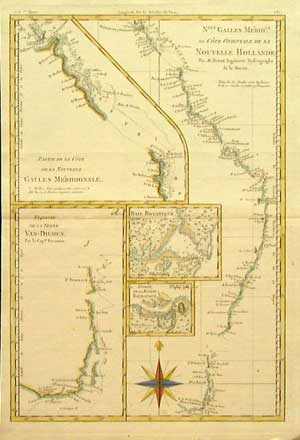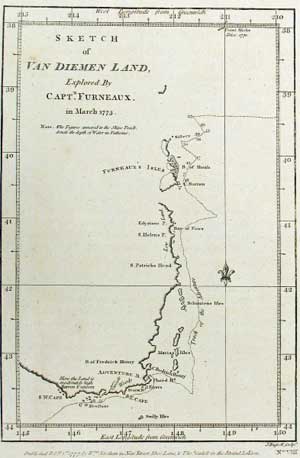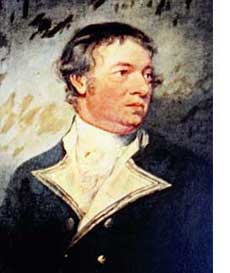

Click to enlarge
Nlle Galles Méridionale ou Cote Orientale De La Nouvelle Hollande. Par. M.Bonne, Ingénieur-Hydrographe de la Marine." - Paris. 1787-1788.
This finely engraved copper plate is divided into 5 separate charts based on a combination of Marion du Fresne's exploration of the coast of Tasmania from Furneaux Island down to Maria Island and Adventure Bay, Furneaux's exploration of the east coast of Tasmania and James Cook's exploration of the mainland's east coast.

Click to enlarge
1777 map of the east coast of Tasmania showing Fureaux's discoveries.

Tobias Furneaux was born in Swilly near Plymouth, Devon, England, on 21st August 1735. He entered the royal navy, and was employed on the French and African coasts and in the West Indies during the latter part of the Seven Years War (1760-1763). He served as second lieutenant of the Dolphin under Captain Samuel Wallis on the latter's voyage round the globe, in fact he was the first British naval officer and explorer who was first to circumnavigate the globe in both directions and among the first Europeans to reach Tahiti.
Furneaux was made a commander in November 1771; and commanded the Adventure which accompanied Cook in Cook's second voyage. Furneaux was made a captain in 1775, and commanded the Syren in the British attack of the 28 June 1776 at Charleston, South Carolina. His was successful in his efforts to introduce domestic animals and potatoes into the South Sea Islands. Furneaux died at Swilly in the Channel Islands, England, on I9 September 1781.
Tobias Furneaux was the commander of Adventure during James Cook's second voyage to the Pacific. Near Van Diemen's Land his vessel became separated from Cook in a fog. Whilst Cook sailed on to New Zealand, Furneaux travelled further north and sighted a group of islands off the south west cape of Tasmania on 9 March 1773.
Mutton Bird Isld
9.3.1772. Furneaux. Descriptive of the type of birds seen in abundance here.
South West Cape
9.3.1773. Furneaux. Its location in relation to the rest of Tasmania.
Mewstone
9.3.1773. Furneaux. rocks there resembled mewstone.
Prion Bay
9.3.1773. Furneaux. The bay is a breeding ground for the Antarctic prion (Pachyptila desolata) and Fairy prion (Pachyptila turtur).
South East Cape
9.3.1773. Furneaux. Its position.
Swilly Islds
11.3.1773. Furneaux. Named after the home town of Furneaux, near Plymouth.
Eddystone Rock
3.1773. Furneaux. Resembled a lighthouse, which reminded Furneaux of eddystone Lighthouse in England.
Adventure Bay
11.3.1773. Furneaux. Named after Firneaux's expedition vessel, HMS Adventure, which was anchored there. Named Storm Bay by Tasman, 1.12.1642, as he sheltered here during a storm on previous day. Map makers incorrectly marked present day Storm Bay as the place where Tasman sheltered and the name has been retained.
Wineglass Bay
17.3.1773. Furneaux. Its shape.
St Patricks Head
17.3.1773. Furneaux. Discovered on St Patrick's Day.
St Helens Pt / St Helens Isld
17.3.1773. Furneaux. Believed to be taken from St Helen's, an uninhabited island in the Isles of Scilly. These islands, which form an archipelago off the south-westernmost tip of the United Kingdom, are near Furneauz's birthplace, Swilly.
Bay of Fires
18.3.1773. Furneaux. Many fires seen along this shore.
Eddystone Point
18.3.1773. Furneaux. Resembled a lighthouse, which reminded Furneaux of eddystone Lighthouse in England. Named Fleurieu Pt by Baudin, 28.2.1802, after Charles Claret de Fleurieu (1689-1755), French philosopher and publisher.
Lookout Heads
9.3.1773. Furneaux. Used as a lookout.
Admiralty Channel
9.3.1773. Furneaux. Named after The British Admiralty, Furneaux's employer.
Cape Barren Island
9.3.1773. Furneaux. The island upon which Cape Barren was located.
Cape Barren
9.3.1773. Furneaux. It appearance.
Cone Pt
9.3.1773. Furneaux. It appearance.
Passage Isld
9.3.1773. Furneaux. its location in a passage.
Furneaux Group
9.3.1773. Cook. Its discoverer and expedition leader, Tobias Furneaux.
Long Pt
9.3.1773. Furneaux. Its shape.
Hummock Isld
9.3.1773. Furneaux. Its shape.
Endeavour Reef
Possibly named after Cook's vessel for his second voyage of discovery, HMS Endeavour. Captain Cook and William Bligh visited the area in March 1776 on James Cook's third and final voyage of discovery in the Resolution and Discovery.
Sister Islands (East and West)
19.3.1773. Furneaux. Two similar islands.